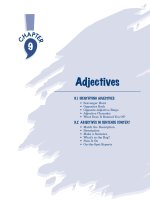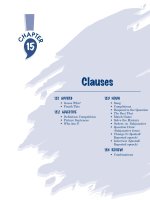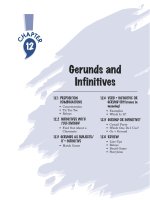fun With Grammar - Verbs - Present
Bạn đang xem bản rút gọn của tài liệu. Xem và tải ngay bản đầy đủ của tài liệu tại đây (434.14 KB, 24 trang )
1.1 SIMPLE PRESENT
• In Common
• Are You the One?
• Short Answers 1
• Short Answers 2
• Information, Please
• Human Bingo
• Twenty Questions 1
• Twenty Questions 2
• Clue
• Memory Round
(Frequency adverbs)
• Ball Toss (Frequency
adverbs)
• How Often? (Frequency
adverbs)
• Picture Search
(Be/Have)
• Want/Need
1.2 NONPROGRESSIVES
• Relay
• Ball Toss
1.3 PRESENT PROGRESSIVE
• Act It Out
• Picture Sentences
• What’s Happening in
Your Country?
• Description (Simple
present and Present
progressive)
• Imagination
• Complaints (Always)
Verbs: Present
1
1.1 SIMPLE PRESENT
1. IN COMMON
Materials:
Worksheet 1
Dynamic:
Whole class
Time:
20 minutes
Procedure:
1. Create a worksheet, perhaps by using the blank Worksheet 1, by
listing your students’ names in the left column. Another way to do
this is to use the attendance list, block out everything but the
name column, then draw lines across.
2. Give each student a copy of the handout. Instruct students to cross
out their name and the names of any absent students.
3. Instruct students to circulate and find one thing they have in
common with each other student on the list. They must find a
different thing for each student. For example, Soheyla might write:
Juan: We both like sports.
Maria: We both have dark hair.
Akiko: We both have two older brothers.
Kimtien: We both drive a car.
4. When two students have discovered something in common, each
writes it down on the line next to the name of the student he/she is
talking to. In the above example, Soheyla writes We both like sports
next to Juan’s name, and Juan writes it next to Soheyla’s name.
5. When they have finished, the students sit down. Ask which verb
tense they used most often (simple present) and why (facts). If the
students cannot provide these answers, give them clues by
soliciting some of the sentences they wrote down. Ask if these are
true statements, etc.
6. For fun and to learn more about the students, ask individual
students at random what they have in common with someone on
their list. (It would take too long to go over all the answers.) You
may want to collect the papers to use as a source of information for
preparing other activities or exercises.
NOTE: This is a good culmination game at a lower level, after
completing the present tense chapter. It also works well as a review
for higher students to see if they remember why they use the present
tense.
2
3
2. ARE YOU THE ONE?
Materials:
Worksheet 2
Dynamic:
Whole class
Time:
20 minutes
Procedure:
1. Distribute one copy of the worksheet to each student. Tell students
to circulate, asking the questions on the worksheet.
Example: On the worksheet: is afraid of spider
Student A: Are you afraid of spiders?
Student B: Yes, I am.
2. When the questioning student gets a yes answer, he/she fills in the
answerer’s name. If the answerer answers no, the questioning
student continues until he/she finds someone who answers yes.
3. When a student completes the worksheet, he/she sits down, but
still answers other students’ questions. Not all students may be
able to complete every entry. If they have asked all their
classmates a question and no one has said yes, they can also sit
down.
4. Go over as many of the questions/answers as time allows.
NOTE: You can limit answers to only one yes answer per student.
This avoids students pairing up and talking to only one or two
other students. Or you may allow students to write a classmate’s
name as many times as that student answers yes.
3. SHORT ANSWERS 1
Materials:
Strips with answers (Worksheet 3)
Dynamic:
Pairs/Small groups
Time:
20 minutes
Procedure:
1. Divide the class into pairs or groups of three or four.
2. Give each group several strips with short answers on them. Have
the students work together to write questions for the answers.
3. The members of each group can take turns reading their questions
and answers aloud, or one student can read for the group. The rest
of the class judges whether the questions are appropriate for their
answers.
4. SHORT ANSWERS 2
Materials:
None
Dynamic:
Pairs/Small groups
Time:
30 minutes
Procedure:
1. Divide the class into pairs or groups of three or four. There should
be an even number of groups if possible.
2. Each group writes five short answers on a piece of paper,
exchanges answer papers with another group, and writes
appropriate questions for the other group’s answers.
Examples:
Group 1: Yes, I do. Group 2: Do you walk to school?
No, he wasn’t. Was John late for class?
No, you aren’t. Am I from Korea?
Yes, they did. Did they leave at 12:00?
No, she didn’t. Did Keiko lend you her
car?
3. Put the two groups together and have them return the answer
papers. The group who wrote the answers checks that the
questions are appropriate.
NOTE: This activity can be adapted to a higher level by using
different tenses, such as a mixture of perfect tenses.
SUGGESTION: Before dividing your class into pairs, tell them what
tense to use or, for the higher-level class, if the activity is intended to
be a verb review.
5. INFORMATION, PLEASE
Materials:
Worksheet 4 (optional)
Dynamic:
Pairs
Time:
30–45 minutes
Procedure:
1. Divide the class into pairs. Assign each pair a different topic to
discuss. Partner A asks the questions; partner B provides his/her
own answers. Partner A can use the worksheet questions as a
guideline, but encourage students to think of other, more specific
questions. For low-level students, you may want to provide answers
for partner B or have the partners work together to create
answers. Higher-level students can use the worksheet as a guide
and then develop their own questions based on the situation.
4
5
SUGGESTED TOPICS: mall information desk
airline information
ticket booth
county fair information office
bus information
college information line
library
hospital information desk
local tourist attraction
2. Have the students practice their questions and answers several
times. They will do a telephone role play for the class, so they
should be familiar with the questions and answers. Circulate,
helping the pairs with their grammar and checking their answers.
3. The partners take turns presenting their role plays to the rest of
the class.
6. HUMAN BINGO
Materials:
Worksheet 5
Dynamic:
Whole class
Time:
15 minutes
Procedure:
1. Go over question formation if necessary. If this is used as a review,
the students should be able to form questions from the prompts.
Give a copy of the handout to each student.
2. Tell them to circulate, asking their classmates questions as
indicated by the prompts on the bingo card. If a student answers
yes, they write that student’s name after the prompt. If the
student answers no, they continue asking until they find someone
who answers yes.
3. As in Bingo, there are several ways to win.
a. The first student who gets five names in a row wins.
b. The first student who fills in the four corners wins.
c. The first student who completes the board wins.
d. The first student who makes a cross wins (third row down and
third row across).
e. Use any other variation you choose.
4. After you have a winner, go over the tense used and why (fact or
habit?) and some of the answers (“Whose favorite color is green?”
“Who gets up at 7:00?”).
Variations:
a. Make your own grid from information you know about your
students. They will be more likely to be able to complete the game.
b. Use at holiday times with prompts geared to the holiday.
Examples: Has seen a ghost, Will go to the costume party
tonight, Has eaten candy corn, Knows what a
ghoul is.
7. TWENTY QUESTIONS 1
Materials:
None
Dynamic:
Whole class
Time:
10 minutes
Procedure:
1. Choose a category, such as famous people, occupations, food, or
animals. Choose one student to answer questions from the rest of
the class. Show the student a piece of paper with a word telling
what he or she is (an object or person in the category). This student
sits in front of the class and may answer only yes or no to any
question.
2. The class may ask a total of 20 yes/no questions to discover the
“identity” of the student in front of the class (the word on the paper
the student was shown). If they guess the student’s identity before
or by the 20th question, the class wins. If the class does not guess
correctly, the student wins. (Although this is based on the popular
Twenty Questions game, you may want to vary the number of
questions the class can ask. Be sure to make the number clear
before the game begins.)
Variation:
To make the game more challenging, especially at the higher levels,
omit step 1 so that the students use up some of their questions
determining the category.
8. TWENTY QUESTIONS 2
Materials:
Small pictures
Dynamic:
Whole class
Time:
10 minutes
Procedure:
1. Tape a small picture on the back of each student, staying within
the same category, such as famous people or occupations.
6
7
2. The students circulate and ask each other yes/no questions to
discover “who” or “what” they are. The responding students look at
the picture on the back of the questioner before answering.
Circulate around the class to help out if the students are not sure
of an answer. Instruct the students that they can answer I don’t
know if they are unsure and you are not available to ask. In the
example below, the first two questions can be answered with yes or
no just by looking at the picture. The third question requires that
the student know the identity of the person in the picture.
Examples: Am I a woman?
Do I have blond hair?
Am I a singer?
3. For a competition, the first student to discover his/her identity
wins. If it is not a competition, set a time limit and try to have as
many students discover their identities as possible. When students
discover their identity, have them continue to participate by
answering questions from those students who are still trying to
guess their identity.
9. CLUE
Materials:
None
Dynamic:
Whole class
Time:
20 minutes
Procedure:
1. This is another variation of Twenty Questions. Choose one student
to come to the front of the class. This student will be given an
identity and will give clues to the class. The class tries to guess the
identity from the clues and can ask only yes/no questions.
2. Before starting the game, discuss strategy with the class. Tell
them that the student who is giving clues will give the most
difficult clues first and the easiest last.
Example: Identity: baseball
SAMPLE CLUES: Many people like me.
You can watch me.
It is (or I am) done outdoors.
I am a game/sport.
You need a mitt to play.
3. If the class guesses the identity, it wins. If the class cannot guess
the identity after a preannounced number of clues (between 5 and
10), the student wins.
Variation:
Send one student out of the room. Give the class an identity for that
student, discuss clue strategy, and go over possible clues. When the
student returns, the class members begin giving clues. The student
may ask only yes/no questions, or you may limit his/her questions to
identity questions (“Am I a teacher?”). If the student guesses his/her
identity, he/she wins. Otherwise, the class wins.
10. MEMORY ROUND (Frequency adverbs)
Materials:
3”x 5” cards with a frequency
adverb written on each
Dynamic:
Whole class
Time:
20 minutes
Procedure:
1. Prepare one card for each student. The words should be large and
in dark ink so that all the students will be able read them.
Depending on the size of the class, you may have to duplicate cards
or play in two rounds. (For example, divide the class in half and
have the first group come to the front of the class. When they are
finished, have the second group come up.)
FREQUENCY ADVERBS: always, almost always, usually, often,
sometimes, frequently, generally, occasionally, seldom, rarely, never,
almost never, hardly ever
2. The students form a circle, either sitting or standing. Ask who has
the best memory. Start with the person next to the volunteer so
that the person who said he/she has the best memory will be last.
(If you know who your weaker/quieter student is, start with
him/her.)
3. Each student makes a sentence using his/her frequency adverb,
but no writing is allowed at any time.
Examples: Never: I never eat fast food.
Always: I always brush my teeth.
Seldom:
I seldom study for tests.
4. Holding the card with the frequency adverb toward the circle, the
first student says his/her sentence. The second student says his/her
sentence and repeats the first student’s sentence. The third
student says his/her sentence and repeats the first two sentences,
and so on around the circle until the last student, who says his/her
sentence and repeats the sentences from everyone in the group.
Don’t allow any writing, but do allow gestures and even one or two
helpful words from the other students.
8
9
Example:
Student 1: I never eat fast food.
Student 2: I always brush my teeth, and Jae never eats fast
food.
Student 3: I seldom study for tests, Akiko always brushes
her teeth, and Jae never eats fast food.
Student 4: I usually go to bed at 11, Maria seldom studies
for tests, Akiko always brushes her teeth, and
Jae never eats fast food.
SUGGESTION: You may want to choose a topic before playing so
everyone’s sentences will relate to that topic.
11. BALL TOSS (Frequency adverbs)
Materials:
Any soft ball or beanbag
Dynamic:
Whole class
Time:
10 minutes
Procedure:
1. Arrange students in a circle, either standing or at their desks.
2. Ask a question using a frequency adverb, and toss the ball to a
student.
Examples: Do you always eat breakfast before coming
to class?
How often do you wear jeans to class?
3. The student who catches the ball must answer, using a frequency
adverb in a complete sentence. The same student then asks a
question with a frequency adverb and tosses the ball to a classmate.
12. HOW OFTEN? (Frequency adverbs)
Materials:
Worksheet 6
Dynamic:
Pairs
Time:
20 minutes
Procedure:
1. Divide the class into pairs. Give each student a copy of the
worksheet, and have students interview each other, writing the
answers on their worksheet. Have the pairs work together to do
Part 2.
2. Share answers from Part 1 with the entire class. Check the
answers for Part 2 and discuss any incorrect ones with the group.









